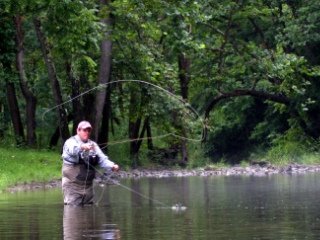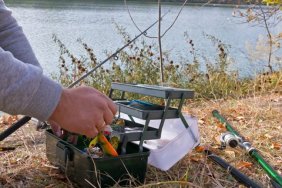 He noticed the selection I held and asked if I was a fly-fisherman as well. Like most fly anglers, when I responded that I wasn’t, he looked shocked and proceeded to tell me about all the benefits and joys that accompany the sport. Eager to learn what I could, I listened with interest and absorbed quite a bit—most of which I’ll never be able to remember, however. One tip he enlightened me with, though, was finding a remedy for any faults in your fly casting, which I’d like to outline for any aspiring fly anglers.
He noticed the selection I held and asked if I was a fly-fisherman as well. Like most fly anglers, when I responded that I wasn’t, he looked shocked and proceeded to tell me about all the benefits and joys that accompany the sport. Eager to learn what I could, I listened with interest and absorbed quite a bit—most of which I’ll never be able to remember, however. One tip he enlightened me with, though, was finding a remedy for any faults in your fly casting, which I’d like to outline for any aspiring fly anglers.
When it comes to casting, a good forward cast is easy for most fly-fishermen because they can watch the fly line and correct any visible errors. However, the trouble many anglers have is during the backcast, as it’s hard to see over your shoulder and make any necessary adjustments. This problem results in poor backcasts, and ultimately, the overall cast will suffer as well. If you’re such an angler who’s having a little trouble with your backcast, such as hitting the water or ground behind you with your line, there’s an easy way to practice in your own yard that will improve your cast immensely.
You’ll need a target in order to practice in your yard; a hula hoop works well, and ambitious casters can use a paper plate. Once you have a target, the steps to a better cast are as follows:
1. Stand sideways to the target, with your feet spread comfortably.
2. Lower your rod so that it’s parallel to the ground and cast sidearm, instead of overhand.
3. Watch the line as you make your backcast and forward cast.
4. Adjust your timing and stroke until the line casts smoothly and forms narrow loops forward and backward
5. Turn back towards your target and cast with an overhand motion now, instead of a sidearm
You’ll see that the timing and the motion remain nearly identical, even though the casting plane changes from horizontal to vertical. Pretty easy, right? Like I said, I don’t fly fish, but listening to the man explain this easy process actually made sense to me. All you do is practice sidearm, facing away from the target so you can see the entire cast, and then continue the arm motions and cadence with an overhand cast once you’ve got the rhythm down. I hope the kind man’s advice helps anyone with casting problems and you find your next trip out to be a less stressful one. Good luck and if I see him at the bookstore in the future, I’ll be sure to thank the helpful fly fisherman on behalf of you all, as well as myself.








